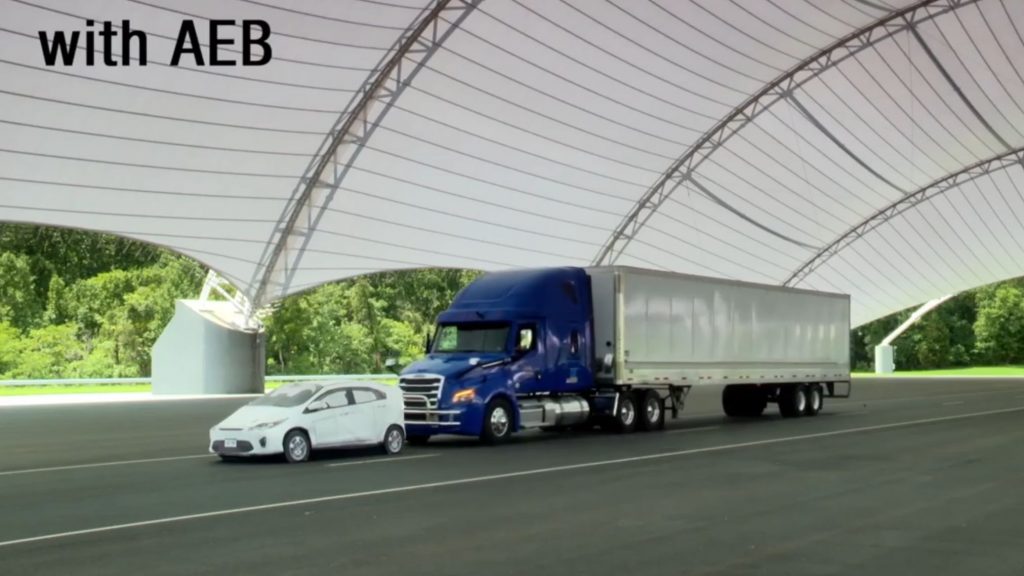
The U.S. DOT’s NHTSA (National Highway Traffic Safety Administration) has completed the loop in AEB (automatic emergency braking) system mandate proposals. This week, the organization and the FMCSA (Federal Motor Carrier Safety Administration) announced a Notice of Proposed Rulemaking that would require heavy vehicles to have AEB systems to mitigate the frequency and severity of rear-end crashes. Late last month NHTSA proposed a similar rule that would require AEB systems in passenger vehicles and light trucks.
If finalized, both rules will have a profound impact on vehicle development for a technology that so far has seen mixed results in the market.
The heavy-vehicle announcement “is an important step forward in improving safety on our nation’s roadways by reducing, and ultimately eliminating, preventable tragedies that harm Americans,” said NHTSA Chief Counsel Ann Carlson.
“Establishing AEB standards is a key component of the Department’s National Roadway Safety Strategy,” said FMCSA Administrator Robin Hutcheson.
The National Roadway Safety Strategy, launched in January 2022, is complemented by the large safety funding boost included in the Bipartisan Infrastructure Law.
According to NHTSA statistics, there are about 60,000 rear-end crashes a year in which the heavy vehicle is the striking vehicle. Once implemented, NHTSA estimates the proposed rule will prevent 19,118 crashes, save 155 lives, and prevent 8814 injuries annually.
The proposed rule, which fulfills a mandate under the Bipartisan Infrastructure Law, defines heavy vehicles such as trucks and buses as those having GVWRs (gross vehicle weight ratings) greater than 10,000 lb. The proposed heavy vehicle standard would require the technology to work at speeds ranging from 6 to roughly 50 mph.
Public comments on the proposed heavy-vehicle rule will be accepted for 60 days.
A similar rule proposed by NHTSA at the end of May would require AEB systems in passenger vehicles and light trucks. If finalized, the organization believes the rule would save at least 360 lives and reduce injuries by at least 24,000 annually. It would also result in significant reductions in property damage caused by rear-end crashes. Many crashes would be avoided altogether, while others would be less destructive.
An AEB system uses various sensor technologies and subsystems to detect when a vehicle is close to crashing and automatically applies the brakes if the driver has not done so or applies more braking force to supplement the driver’s braking as necessary to mitigate the severity of the crash.
“Our proposed rule would require all cars to be able to stop and avoid contact with a vehicle in front of them up to 62 mph,” Carlson said. “And the proposal would require pedestrian AEB including requiring that AEB recognize and avoid pedestrians at night.”
If adopted as proposed, nearly all U.S. light vehicles, with GVWRs of 10,000 lb or less, will be required to have AEB technology three years after the publication of a final rule.
In March 2022, the IIHS (Insurance Institute for Highway Safety) and its HLDI (Highway Loss Data Institute) petitioned federal regulators to require manufacturers to equip new passenger vehicles with AEB systems capable of detecting and avoiding pedestrians in the dark as well as daylight. HLDI analysis of insurance claims and an IIHS study of police-reported crashes had found large benefits from pedestrian AEB, but the IIHS study found that the systems have virtually no positive effect at night or on unlit roads—when more than a third of fatal pedestrian crashes occur.
“Pedestrian AEB that works well at night is a game changer for protecting the most vulnerable people on the road,” said IIHS-HLDI President David Harkey.
IIHS and NHTSA brokered a 2016 commitment by 20 OEMs to equip nearly all their light-duty cars and trucks with AEB by September 2022. While the IIHS tests AEB systems at 12 and 25 mph, the NHTSA proposal will ensure that the systems also work at higher speeds.

